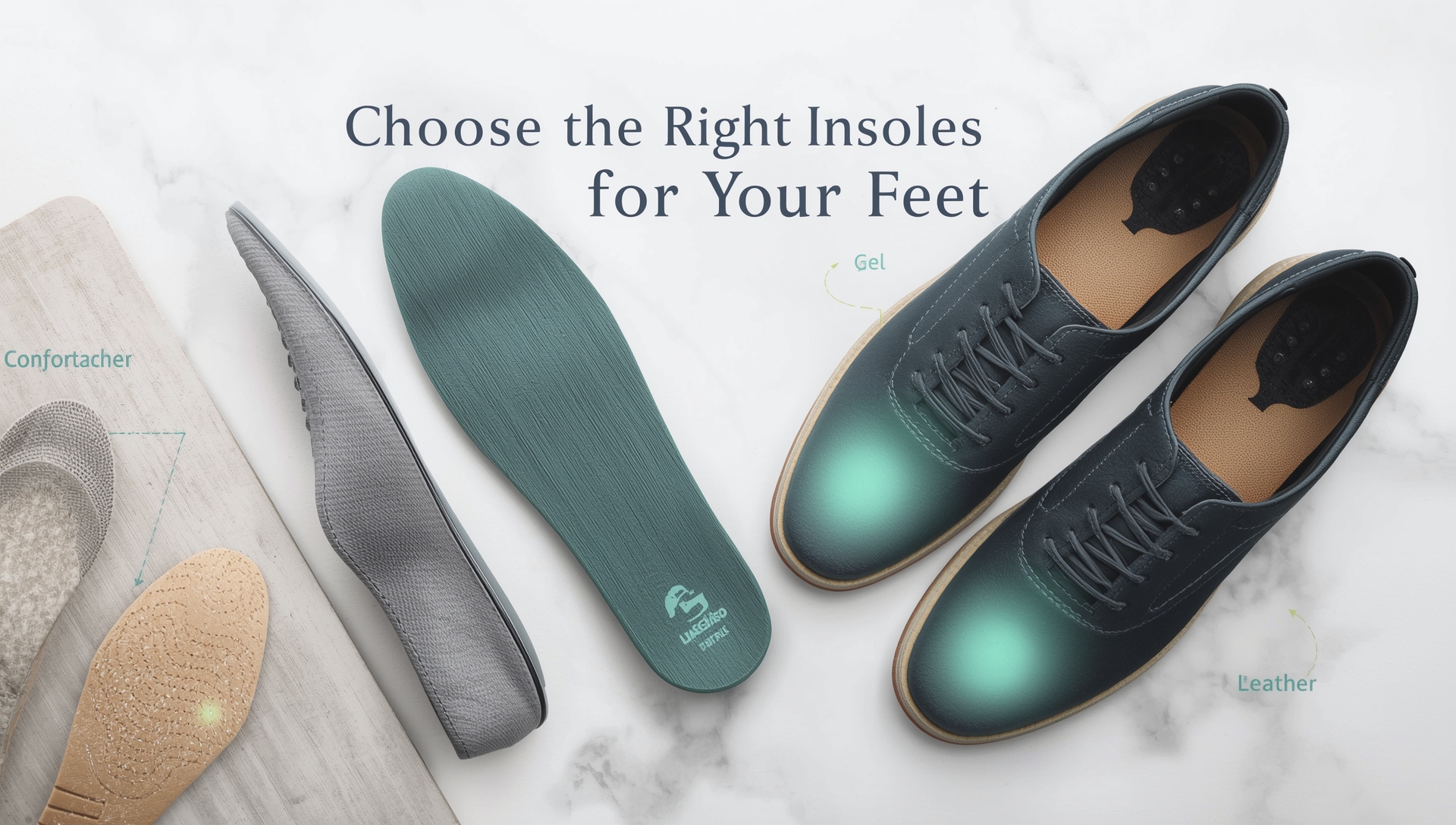
When buying a new pair of insoles, the first thing to notice is the feeling they give to your feet. A smooth and molded surface can make wear more comfortable, whether you’re putting them in office shoes or taking them on the road for a race. Leather insoles often add a sleek touch and prevent scuffs, enhancing both style and comfort in the process of “Choose the Right Insoles for Your Feet.”
Supportive insoles can reduce suffering from foot ailments or disorders, making a great long-term investment. When purchasing, check how bouncy and supportive they feel as you play sports, walk, or wear converse casually. Adding them easily into shoes ensures every step feels deliberate and comfortable, reinforcing the value of “Choose the Right Insoles for Your Feet.”
Even if the box seems ordinary, the right insoles can transform foot feeling instantly. Buying them with attention to smooth, leather, or bouncy materials matters whether for office, race, or everyday road wear. Taking your time in “Choose the Right Insoles for Your Feet” ensures supportive, long-term comfort that truly matters.
What Are Insoles?
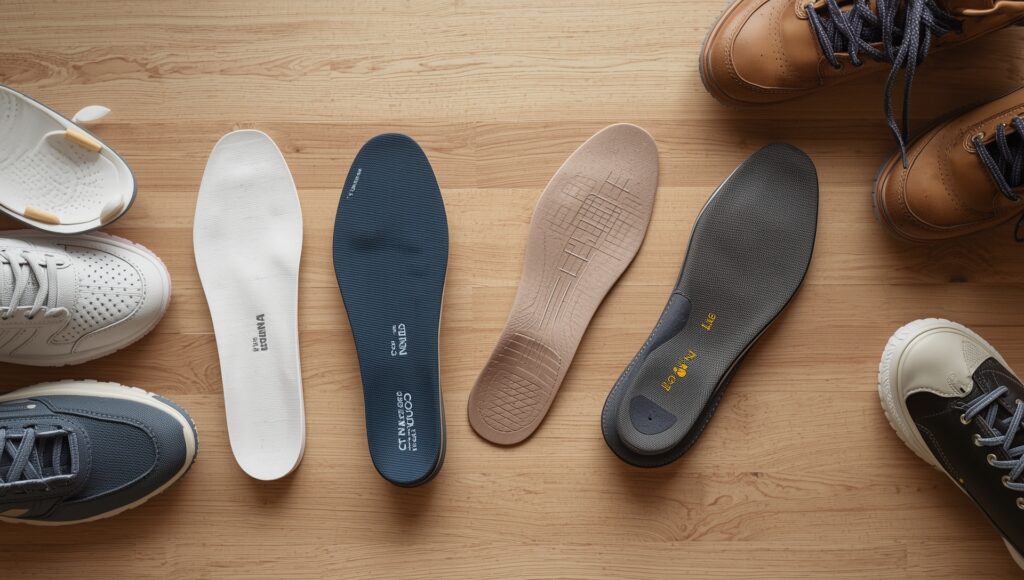
Insoles are small pieces of padded material placed inside shoes or boots to improve comfort and support for your foot. These beds are designed to fit specific shoes or liners, providing warmth and extra room while wearing. When selecting the right insole, it’s important to keep in mind the specific purpose, whether to add better support or extra cushioning.
May be This can Help You: 7 Best Insoles for Flat Feet: Expert Choice
Choosing the Right Fit
To make your shoes feel more comfortable, existing shoe liners can be removed to come with insoles that fit properly. Insoles are usually made from various materials, and choosing the right type ensures better comfort and support throughout the day. Always select a piece that adds extra room inside boots or shoes without altering the fit of your foot.
Maximizing Comfort and Support
The main goal of Choose the Right Insoles for Your Feet is to make your shoes feel more comfortable and supportive. Insoles can come in padded material, designed to add extra comfort, warmth, and support while wearing. Always keep in mind how they fit in your shoes and whether they make the foot beds feel natural and better.
Are Insoles The Same As Orthotics?
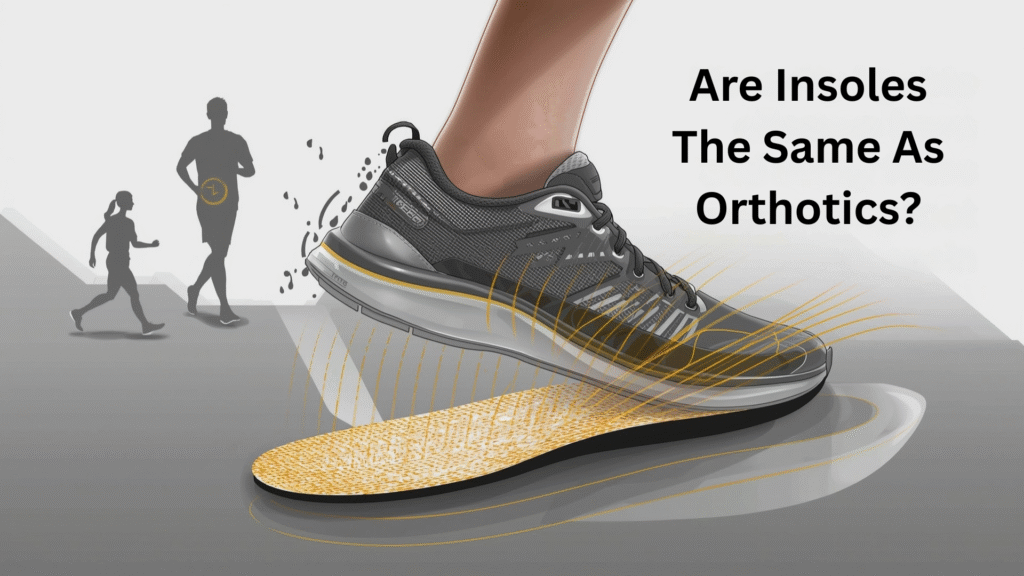
Many people use the words insole and orthotic interchangeably, but in Choose the Right Insoles for Your Feet, it’s important to know they differ in exact function. Insoles provide cushioning, padding, and extra support for shoes, while orthotics are custom made to fit the foot shape precisely. For general comfort, insoles are effective, but for serious foot issues, orthotics provide similar protection and shock absorption.
Choosing Between Insoles and Orthotics
Insoles in Choose the Right Insoles for Your Feet are generalized, designed to cushion and protect feet for people needing extra padding. Orthotics, however, are custom made to fit your foot exact contours, offering better support and shock protection. Deciding which to use depends on whether you want generalized comfort or exact correction for foot issues.
Making the Right Choice
To make the most of Choose the Right Insoles for Your Feet, consider insoles if you need extra cushioning and padding, but orthotics if your feet need custom support to protect them from stress. Both provide similar benefits, yet orthotics differ by exact fit, while insoles offer a generalized cushion that works well in most shoes. Knowing the difference ensures your feet stay comfortable and protected.
Common Reasons to Buy Insoles
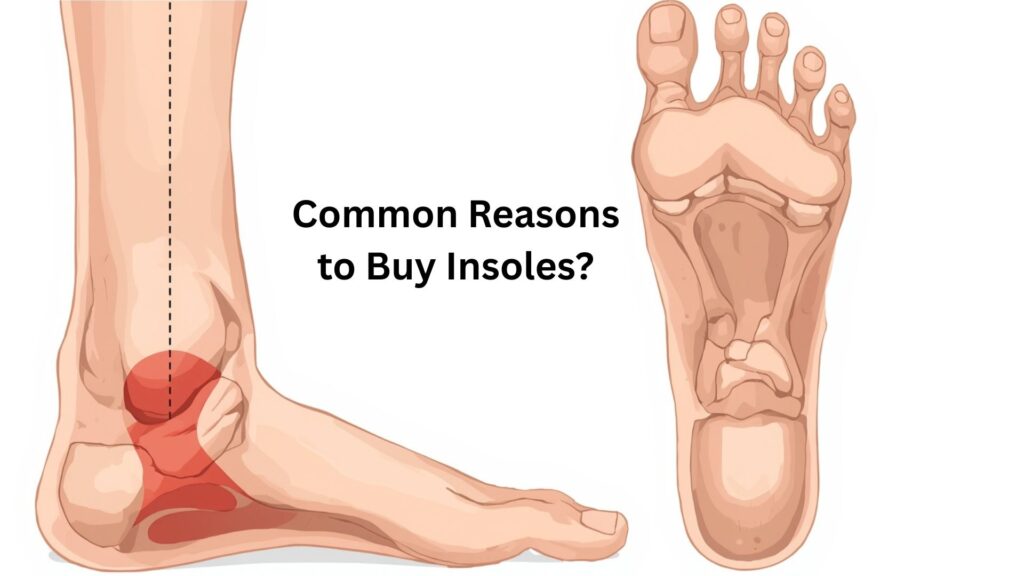
Many people turn to insoles for shoes to relieve pain and improve comfort, and in Choose the Right Insoles for Your Feet, I’ve found they provide support in multiple ways. Whether for athletic performance or everyday purposes, the right insoles add extra space and cushioning to help your feet feel better. From my experience, feetnest.com shows how insoles can improve posture, comfort, and overall foot health seamlessly.
How Insoles Relieve Pain
insoles, relieve, pain, existing, condition, support, shoes, prevent, worsening, happening, experiencing, doctor, treatments, conditions, customers, reasons, buying, plantar, fasciitis, morton’s, neuroma, metatarsalgia, ball, foot, back, knee, shin, splints, gout, explore, help,
Insoles Help With Plantar Fasciitis & Arch Pain
Dealing with plantar fasciitis or arch pain can be frustrating, but insoles in Choose the Right Insoles for Your Feet support the foot by relieving strain on the heel, fascia, and band of tissue that connects the bone to toes. When the fascia is swollen or inflamed, insoles help distribute pressure across the entire foot, reducing pain while you stand or walk.
From personal experience, insoles in Choose the Right Insoles for Your Feet learn to support every step by cushioning the arch and heel, preventing the strain that causes inflamed fascia and pain. Using the right insole not only eases plantar fasciitis but also keeps the entire foot aligned, making it easier to stand, walk, and stay comfortable all day.
Insoles Help With Morton’s Neuroma
Insoles play a vital role in Choose the Right Insoles for Your Feet, especially for Morton’s neuroma, a condition causing pain, numbness, and tingling in the forefoot and toes. The thickening of the nerve between metatarsal bones can affect sensation in the area, but properly designed insoles help relieve pressure and improve comfort.
From my experience, insoles in Choose the Right Insoles for Your Feet can provide targeted support for plantar intermetatarsal spacing, reducing the neuralgia linked to Morton’s neuroma. They help redistribute weight, ease metatarsalgia, and learn how to support the forefoot for long periods of standing or walking.
Choosing insoles for Morton’s neuroma in Choose the Right Insoles for Your Feet requires attention to forefoot padding, the thickening nerve location, and proper sensation alignment. These insoles ensure your toes and area are protected while reducing pain and tingling, making every step more comfortable and preventing metatarsalgia or further neuroma aggravation.
Insoles Help With Metatarsalgia & Ball-of-Foot Pain
Choosing the right insoles can make a huge difference if you struggle with metatarsalgia or ball-of-foot pain. From personal experience, I noticed a sharp aching and burning sensation beneath my ball when standing or walking for long periods. A broad understanding of this condition helps you pinpoint specific areas of discomfort and select insoles that fit your shoe perfectly.
When shopping, think about how your activities affect your foot. If pain gets worse after hours of standing or walking, try insoles designed to distribute pressure away from the ball. A pebble-like sensation or lingering pain is a sign you need targeted support rather than a generic insert.
To learn which insoles suit you, consider broad cushioning versus specific pads aimed at metatarsalgia relief. My experience showed that proper fitting insoles can turn discomfort into comfort, allowing normal activities without the dreaded burning pain beneath the foot.
Insoles Help With Back Pain
Using the right insoles can drastically reduce back pain, a common struggle in daily life. From personal experiences, I noticed a dull aching and occasional throbbing that sometimes turned into pinching sensations. Understanding the causes, like poor support from your feet, is the first step to relief.
Not all insoles are equal; their effectiveness depends on the intensity of pain, whether mild or severe. Choosing inserts that properly align and cushion your feet can prevent further aching. Over time, I learned small changes in support can significantly improve posture and reduce back pain.
To truly learn what works, experiment with various insoles until your feet feel fully supported. The difference between mild discomfort and severe pain can be dramatic when support is optimized. My experiences confirm that consistent use of the right insoles reshapes how you move through life.
Insoles Help With Knee Pain
When experiencing pain in your knee, it’s important to learn how insoles can make a difference. Many causes of discomfort, like arthritis, cartilage tears, or tendonitis, often stem from the way your feet and arches interact with the ground while walking. One key factor to consideration is selecting insoles that properly support your unique arches.
Custom insoles not only ease knee pain but also address underlying causes such as weak cartilage or repetitive strain from walking. For arthritis sufferers, they cushion joints and reduce pressure, while tendonitis and minor tears benefit from alignment support that stems foot fatigue. Paying attention to how your feet feel with each step is crucial in learning which insoles suit you best.
Even small adjustments in arches support can significantly decrease knee pain caused by tendonitis or arthritis. Understanding the causes and noticing where discomfort stems helps in consideration of materials, thickness, and shape of insoles. Personally, I’ve found that walking longer distances feels lighter once insoles properly match my feet and arches, proving their impact is far more than just cushioning.
Insoles Help With Shin Splints
If you’re experiencing throbbing or aching in your shins, insoles can play a major role in easing shin splints. This common condition often appears during running, sprint, or other strenuous physical activity, especially in sports. Knowing how to start with the right support helps you learn which insoles prevent further aching.
Proper insoles stabilize your shins and absorb impact, allowing you to participate in running or sports without having to stop due to pain. The throbbing sensation stems from repetitive stress on your muscles and bones, making correct cushioning a key factor. Paying attention to the intensity of physical activity is essential when choosing insoles for shin splints.
Even light adjustments in insoles can reduce aching significantly and prevent throbbing during strenuous sports or running sessions. By understanding the mechanics of shins and the condition, you can safely start and participate without interruption. From personal experience, once I matched insoles to my gait, shin pain decreased, and physical activity felt smoother and more controlled.
Gout
Gout is a painful condition that affects joints, most commonly at the base of the big toe. The inflammation, swelling, and warmth in the joint make walking uncomfortable, and many experience discomfort with even light movement. To learn how to reduce strain, choosing the right insoles is crucial.
Proper insoles can relieve tenderness along the line of the affected joint while minimizing pressure on the big toe. For those with arthritis or chronic gout, cushioning and support help distribute weight evenly, reducing painful inflammation. I’ve noticed personally that adjusting insoles to match foot shape eases discomfort during walking.
When skin over the joint feels sensitive or warm, insoles act as a buffer, allowing continued activity without aggravating the gout flare. Understanding the condition and where pain stems helps in selecting supportive insoles that prevent extra strain. Once I matched my insoles to my big toe alignment, walking became far less painful, even during flare-ups.
How Insoles Improve Athletic Performance
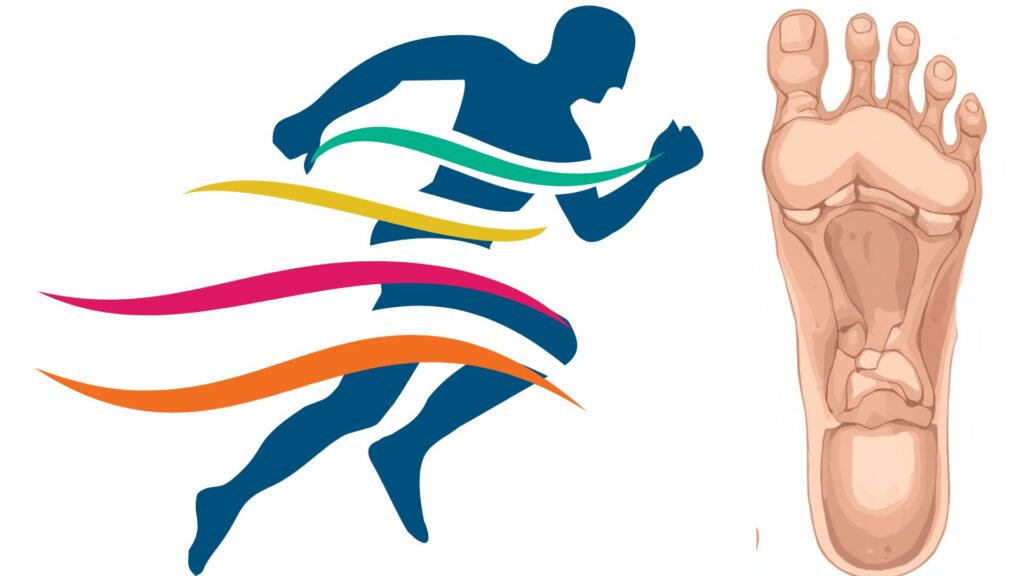
Insoles can relieve pain and prevent conditions occurring from intense athletic activities like running, cycling, basketball, football, baseball, and golf. Choosing ones specifically designed for your sport boosts performance by improving stability, reducing fatigue, and supporting foot mechanics during repetitive motion. Visiting stores that sell a variety of insoles lets you shop for the perfect fit for your activity.
Proper insoles enhance athletic performance by distributing impact, absorbing shock, and protecting joints, which directly helps prevent injuries. From personal experience, switching to sport-specific insoles made long running and basketball sessions smoother, letting me perform at my best while minimizing pain. Whether you shop online or in-store, a variety of insoles designed for your sports ensures consistent support.
How Insoles Provide Support
Insoles provide essential support in shoes, helping reduce the risk of injury and prevent injuries from worsening due to overpronation, arthritis, or diabetic foot conditions. There are multiple ways to customize insoles for your feet, and it’s necessary to explore in detail how additional cushioning or arch support can improve comfort and stability. From my experience, using the right insoles makes daily walking safer while protecting vulnerable feet against strain and long-term damage.
Insoles Provide Support for Overpronation
Insoles offer crucial support for people with low or flexible arches, reducing the risk of injuries caused by overpronation. When the foot tends to roll inward or downward during walking, proper insoles guide natural movement, helping the ankle maintain alignment and prevent strain. Choosing insoles that match your arches ensures that pronation stays normal rather than over or excessive.
For people over pronating, insoles can correct alignment subtly, stabilizing the foot and ankle during activity. They restore natural movement while cushioning pressure points, reducing the risk of chronic injuries. From my experience, wearing the right insoles makes walking feel smoother and prevents the foot from rolling inward unnaturally.
Custom insoles also protect low or weak arches from worsening overpronation over time. By supporting the foot during walking and other movements, they maintain normal pronation and minimize risk of ankle or foot injuries. Personally, I noticed better balance and less fatigue after switching to insoles designed for my arches and overpronating tendencies.
Insoles Provide Support for Arthritis
Insoles provide vital support for arthritis affecting the foot and ankle, helping manage pain from mild to severe symptoms. Different types of arthritis, including osteoarthritis, rheumatoid, and gout, can cause inflammation that limits mobility, and the right insoles reduce stress on joints. One important factor is choosing insoles that match your range of movement and the specific arthritic condition.
For arthritic feet, insoles help absorb shock, maintain alignment, and prevent worsening of pain and inflammation. Different types of arthritis affect joints uniquely, so customizing support for osteoarthritis, rheumatoid, or gout ensures comfort during walking and daily activity. From personal experience, selecting insoles suited to foot shape and arthritis type significantly eased pain.
Using the right insoles consistently protects foot and ankle joints, improving function across a range of movements. They reduce the impact factor that can affect progression of arthritic conditions, making even severe symptoms more manageable. I’ve noticed that proper insoles not only relieve pain but also make daily activity smoother for arthritic feet.
Insoles Provide Support for Diabetic Foot
Insoles provide critical support for the diabetic foot, as people with diabetes are susceptible to problems and complications like neuropathy, peripheral or vascular disease. Proper insoles help prevent calluses and ulcers by improving circulation and cushioning pressure points that could otherwise lead to serious issues. Choosing the right pair early can stop ordinary discomfort from developing into something worse.
For those with diabetic foot concerns, insoles reduce strain, protect sensitive areas, and help manage neuropathy or vascular limitations. If treated poorly, minor pressure points can escalate and may lead to amputation or other serious complications. From my experience, using insoles consistently provides confidence during walking and prevents ordinary problems from developing further.
Custom insoles designed for diabetic feet support foot structure, improve circulation, and minimize calluses or ulcers. Properly fitted insoles reduce the risk of complications from peripheral neuropathy or vascular issues, keeping diabetic feet safer during daily activity. Personally, I’ve seen that insoles dramatically lower discomfort and make walking without pain more achievable.
Types Of Insoles
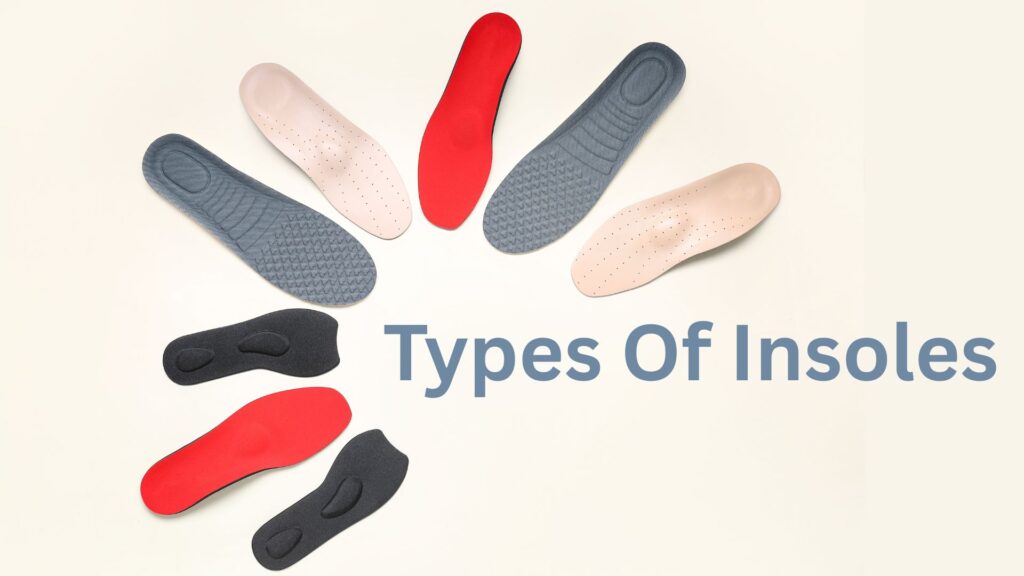
There are many types of insoles to choose from, including orthotic, cushioned, arch supports, flat, athletic, sport, and heavy-duty options. Specific pairs exist for high-heels, high-heel shoes, converse, baseball, and golf, each designed to cushion and stabilize the foot during activity. Understanding the different types helps you select insoles that match your shoe and activity.
Using the right insoles for athletic or casual wear can prevent discomfort and improve performance. Cushioned or arch supports make high-heels or flat shoes easier to wear, while sport and heavy-duty options protect your feet during baseball, golf, or other strenuous activity. Personally, matching the correct pairs of insoles to my shoes drastically reduced fatigue and enhanced comfort.
1) Orthotic Arch Supports
Orthotic arch supports are a specialized type of insoles that feature a rigid or semi-rigid plate or platform to maintain the foot’s natural, healthy shape throughout the day. With a built-in heel cup and arch support, they stabilize the ankle and foot, preventing plantar fasciitis pain and controlling movement during walking. This option is excellent for correcting over-pronation, supination, or collapse in sensitive areas.
These orthotics provide firm arch supports, allowing the foot to walk with proper alignment while reducing pain and stress on critical areas. From personal experience, using insoles with built-in heel cups improved comfort, stabilized movement, and minimized discomfort during long walks. They are a reliable option for anyone needing precise arch support throughout the day.
2) Cushioned Arch Supports
Cushioned arch supports are insoles designed to provide maximum cushioning and relief for foot fatigue in walkers, runners, or those standing long periods. Unlike rigid or semi-rigid orthotics, these flexible, padded insoles cushion sensitive areas and support the arch while accommodating people who suffer from various conditions. The primary goal is focusing on comfort and proper support in everyday situations.
By offering gentle arch supports, these insoles benefit anyone needing soft orthotic assistance without rigidity. Personally, I found that cushioned insoles in my shoes made walking and running far less tiring, providing the desired relief while maintaining proper foot alignment in different situations.
3) Flat Cushions
Flat cushions are simple insoles designed to add extra cushioning and support to your feet. Often used as a replacement or liner inside any shoe, they provide comfort by evenly distributing pressure and protecting sensitive areas. When properly placed, these insoles are useful for everyday walking or standing.
These flat cushions offer minimal arch support but significantly improve comfort in shoes lacking padding. From personal experience, inserting flat insoles in my everyday shoes helped add softness, reduce fatigue, and keep my feet feeling fresh during long hours of standing.
4) Athletic/Sport Insoles
Athletic/sport insoles are specialized, technical insoles designed to enhance performance for runners, cyclists, and snow sports like skiing or snowboarding. Engineered for specific functions, they provide optimal support to the heel, forefoot, and arch, while padding cushions impact and improves gait and movement during activity. Many boots also include insoles that retain warmth for cold-weather sports.
These athletic insoles go beyond standard insoles, offering foot support systems that protect against fatigue and enhance comfort. From personal experience, using insoles with targeted cushion and arch support in sport shoes or boots helped maintain energy and improved performance during long runs and intense snow activities. The list of benefits for each activity is extensive, making them essential for active individuals.
5) Heavy Duty Insoles
Heavy-duty insoles are designed for construction, service, or work environments where feet endure long hours each day. These insoles provide support with reinforced materials and extra cushioning to reduce fatigue and prevent discomfort during demanding tasks. You can browse options to find the right pair for your specific work needs.
Using heavy-duty insoles improves stability and protects feet from strain, making tough workdays more manageable. From personal experience, a well-chosen pair of insoles transformed long hours on my feet into a much more comfortable experience, showing how support and cushioning are essential in any demanding day.
6) High Heel Insoles
High heel insoles help make heels more stylish without the painful risk of foot injury. These slender, low-profile insoles support your feet while preventing discomfort from wearing high-heeled shoes. Brands like Superfeet and EasyFit offer options that carry a high level of comfort despite a number of hours on your feet.
Adding the right high heel insoles transforms your feet experience, reducing pressure points and resulting in longer wearability. From personal experience, insoles that are slender yet supportive allow high-heeled shoes to feel manageable, making it easier to carry style without compromising comfort.
7) Half vs Full-Size Insoles
Insoles come in a variety of materials and sizes, including half-size and full-size inserts, so it’s important to buy knowing the difference. Full-length insoles add extra cushioning and support for the forefoot and heel, while half, short, or three-quarter liners are designed to fit without taking up high volume space in shoes. These options allow flexibility for dress, flats, boat, heels, winter, fashion, or boots.
Choosing between half-size and full-size insoles depends on your specific needs: full-length offers better overall support, while half inserts provide low, minimal cushion for targeted relief. Personally, using removable liners in dress or fashion shoes lets me place support where needed without crowding the shoe, making long wear far more comfortable.
What To Look For When Buying Insoles
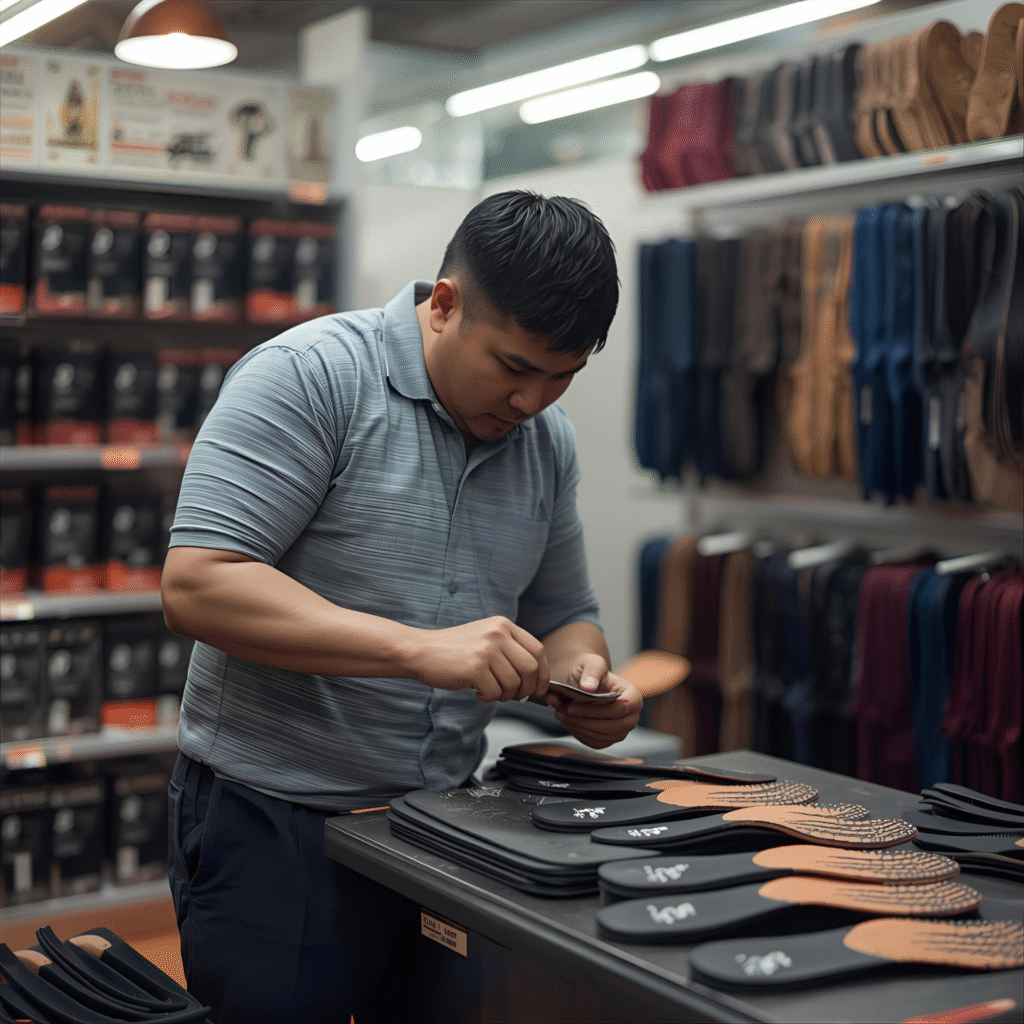
Buying of Insoles According to your Need
When buying insoles, it’s important to look at different criteria to choose the right inserts for your shoes. Consider size, placement, arch, footbed, and material, whether thin for simple shoes or sophisticated for specialized activity. Keeping a checklist in mind while evaluating options ensures the next pair matches your walk and activity needs.
Choosing insoles isn’t just about comfort, matching the type to your shoe and footbed enhances support and prevents fatigue. I recommend testing placement and material to see how it feels during daily walk or sport, ensuring the right inserts follow your activity and shoe requirements seamlessly.
A) Insoles For The Right Activity
To choose the right insoles for your activity, it’s important to consider the type of movement, whether high-impact like soccer or running, or low-impact such as standing all day. Insoles are specifically designed for different activities and shoes, from hiking boots to heels, to provide support where your feet need it most. Browsing a full list of options can help narrow your choices.
Matching a pair of insoles to your favorite shoes or boots ensures maximum comfort and performance. From personal experience, using activity-optimized insoles drastically reduced fatigue during long runs or all-day wear in heels, proving that choosing based on activity is one of the most important reasons to invest in quality insoles.
B) Insoles That Are Properly Sized
Insoles that are properly sized are important to ensure the insole fit matches your shoes and foot comfortably. Sizes typically range across shoe sizes, for example, men’s or women’s, and many inserts can be trimmed to fit perfectly. A specific product often denotes whether it is 3/4-length or full insert, so you can pick the one that corresponds to your measurements.
Properly sized insoles are designed to comfortably sit in your footwear, and many pieces can be trimmed between sizes if needed. From personal experience, buying insoles that generally fit my shoe size and then adjusting down slightly made wear throughout the day much easier and more supportive.
C) Insole Placement
Full-length insoles are designed to completely replace the existing liner in a shoe and come ready to add comfort without removing anything else. They sit inside the shoe as intended, providing even support across the entire foot. For lighter shoes, a thin insole can be added to improve comfort without changing the fit.
A ¾ length insole is placed by hand and only covers the forefoot and arch, making it ideal for shoes where full-length inserts are too bulky. These insoles are designed for targeted support and can be added inside shoes without compromising space or comfort.
From personal experience, carefully choosing insole placement between full-length and ¾ length can make a noticeable difference in comfort and support, allowing long walks or standing sessions to be much more manageable. Proper placement ensures the insole works completely as intended.
D) Insoles for The Right Arch Type
When choosing insoles to match your arch types, it’s essential to understand the risk of painful injury from a poor fit. Feet can have flat, medium, or high arches, which usually fall into three buckets for guidance. Becoming familiar with these categories can guide you toward insoles suited for your arch and reduce the potential for strain.
Browsing options while purchasing insoles requires noting whether they are made for neutral, low, or fallen arches. Medium arch insoles typically provide balanced support, while flat or high arch products target specific areas to relieve pressure. Choosing insoles that match your arch type ensures comfort and proper alignment during everyday activities.
From personal experience, selecting insoles according to arch type prevented fatigue and painful issues, making walking or running much more enjoyable. Always note the arch classification when browsing or purchasing to find the right insole for your feet.
E) Footbed Type
When looking for insoles, understanding the footbed type is key, as orthotic supports come in rigid, semi-rigid, or cushioned constructions. Some have flat cushion designs while others support the arch, so your choice is dependent on the needs of your feet. Browsing various products helps identify which type will suit your needs best.
Cushioned or rigid insoles serve different purposes: cushioned provide comfort for everyday wear, while rigid orthotic supports correct alignment and relieve pressure. Personally, testing a few footbed types revealed which insoles fit my arch needs, making long walks and daily wear far more comfortable.
F) Insole Material
Insoles come in various materials like foam, gel, cork, leather, wool, EVA, plastazote, and plastic, each offering unique comfort and support. They target pressure, fatigue, and orthotic needs. Choosing the right footbed type enhances daily wear, sports, and medical use.
1) Foam Insoles
Foam insoles offer softness and comfort by conforming to the foot shape. This layer in shoes helps absorb shock and reduces fatigue, ideal for high-impact activities. From experience, foam provides gentle cushioning that feels supportive for everyday wear.
2) Memory Foam Insoles
Memory foam acts like a mattress, retaining shapes to create personalized support. It offers plush comfort while targeting pressure points, relieving heel and forefoot stress. Athletes and casual walkers both benefit from its shock-absorbing quality.
3) Gel Insoles
Gel insoles deliver targeted cushioning and absorb impact, perfect for athletes or plantar fasciitis sufferers. Heel and forefoot are protected while fatigue is minimized. I found gel layers extremely effective for long walks or sports sessions.
4) Cork Insoles
Cork insoles are lightweight, eco-friendly, and antimicrobial, molding to your foot for personalized support. They wick moisture, control odors, and remain durable for long-term use. For me, cork insoles suit sustainable footwear and casual shoes perfectly.
5) Leather Insoles
Leather insoles provide a classic, breathable footbed that improves circulation and reduces moisture and odors. Ideal for dress or formal footwear, the bulk is minimal while maintaining elegance. I notice comfort improves significantly in formal settings using leather.
6) Wool Insoles
Wool insoles are perfect for boots during winter, providing warmth and insulation. They help regulate temperature, keeping feet comfortable in hot or cold climates. Personally, wool insoles transformed my winter hikes with consistent warmth.
7) Plastazote Insoles
Plastazote insoles are closed-cell, customizable, and widely used in medical and orthotic settings. Healthcare professionals recommend them for diabetes, arthritis, and other conditions, ensuring proper distribution of pressure. Their specialized design offers unmatched support for sensitive feet.
8) EVA Insoles
EVA (ethylene vinyl acetate) insoles are lightweight, flexible, and durable, offering consistent compression for athletic or casual footwear. They mold to foot shape under heat, sometimes using an oven or cooling process for unique, instant form. I prefer EVA for its versatility and long-lasting support.
9) Plastic Insoles
Plastic insoles are rigid, providing specialized support for orthotic needs. They are best when custom-molded to foot shape, offering precise distribution of pressure. My experience shows plastic inserts are unmatched for correcting pronation or arch issues.
How Long Do Insoles Last For?
The lifespan of insoles or orthotics depends on material, weight, gait, and usage. Softer insoles tend to wear faster, while firm or higher-quality ones last longer. Mileage and daily activity cause variations that customers often notice.
Different brands also affect how long insoles last, with some recommend replacing every 6-12 months. Supportive feel can decline sooner depending on usage, weight, and activity type. I’ve found that premium orthotics retain comfort longer.
Monitoring wear and supportive function is key; insoles may vary in longevity even within the same brand. Tracking mileage and inspecting material helps decide when replacing is necessary. Firm or soft choices affect timing too, so choose based on usage and foot needs.
How to Know When It Is Time To Replace Your Insoles
Pay attention to signs of wearing, flattening, or loss of support in your insoles. Fading, tattered, or split pads and arches indicate it’s time to replace them. Users often notice comfort is compromised after several miles.
Check for tearing, splitting, or weakened areas, especially around the metatarsal or heel. If your favorite pair shows visible appearances of being worn or torn, browse for a new shop or guide to select a proper replacement.
A general rule is every 6 months to a year, depending on usage, mileage, and supporting needs. Regular inspection helps maintain foot health and comfort, ensuring your insoles keep performing optimally.
How to Choose The Right Insoles For You
To choose the right insoles, start with your activity, type of shoe, and foot pain. Determining what will work best for your specific needs is easier with an insole advisor or recommendation.
Narrow your options by arch type, personal preference, and materials; fantastic support and cushioning in shoes help prevent or treat injury. I’ve found trying a few options at home makes picking the perfect pair simple. Many brands offer freeshipping and easy purchase options so you can easilytry and find the insole that suits your feet best. Taking the time to match support with comfort ensures long-lasting satisfaction.
FAQs
What are insoles and why should I use them?
Insoles are padded inserts placed inside shoes to improve comfort, support, and foot alignment. They help reduce fatigue, prevent pain, and enhance overall foot health for daily wear or sports activities.
How do I choose the right insoles for my foot type?
Start by considering your arch type, foot pain, and activity level. Use an insole advisor or recommendation, and select materials and shapes that provide adequate support and cushioning.
Are insoles the same as orthotics?
No. Insoles provide general cushioning and support for comfort, while orthotics are custom-made to correct specific foot conditions and offer precise alignment.
Can insoles help with foot pain or medical conditions?
Yes. Insoles relieve plantar fasciitis, Morton’s neuroma, metatarsalgia, and general foot strain. They also support conditions like arthritis, gout, and diabetic foot issues.
How do insoles improve athletic performance?
Sport-specific insoles distribute impact, absorb shock, and stabilize the foot, reducing fatigue and improving gait. They enhance performance in running, cycling, basketball, and other sports.
How do I know when it’s time to replace my insoles?
Check for signs like flattening, loss of support, tattering, or splitting. Typically, insoles should be replaced every 6–12 months, depending on usage, weight, and activity.
What materials are insoles made from?
Insoles come in foam, memory foam, gel, cork, leather, wool, EVA, Plastazote, and plastic, each offering unique support, cushioning, and comfort for specific needs.
What types of insoles are there for different activities?
There are athletic/sport, heavy-duty, high-heel, flat cushions, orthotic arch supports, and cushioned arch supports, each tailored for performance, comfort, or corrective support.
Should I use full-length or ¾-length insoles?
Full-length insoles replace the existing liner and provide overall support, while ¾-length insoles focus on the forefoot and arch, fitting snugly without taking up too much space.
Can insoles help with knee, back, or shin pain?
Absolutely. Proper insoles support arches, correct gait, and absorb impact, reducing stress on knees, back, and shins, preventing worsening conditions and promoting long-term comfort.










[…] this Guide will help you a lot: Choose the Right Insoles for Your Feet […]